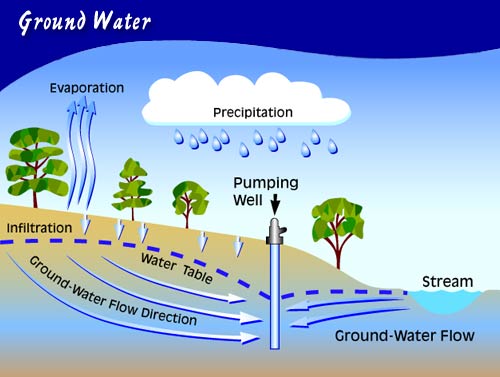
What is Groundwater?
Groundwater is all the water stored in the spaces, voids, pores, and fractures in soil and rock below the earth’s surface. Geologic formations that can provide usable quantities of groundwater to a well are called “aquifers”. Groundwater is recharged as rain, snow and other surface water sources such as rivers and streams that seep downward through surface soils and fill any open spaces below ground.
Groundwater moves significantly slower than surface water. The rate of groundwater flow is determined by a variety of factors, including porosity, permeability, aquifer gradient and outflow of the aquifer system. Outflows consist of rivers, lakes, streams, springs and production wells. Groundwater movement is commonly measured in terms of feet per day, but in some systems, movement can be measured in terms of inches per year! In our region, it has been determined that groundwater moves about 12” per day. As it approaches production wells, that changes.

Porosity refers to the capacity of earth materials to hold water in spaces found within and between sediments and rock. Well sorted sediments, i.e. evenly distributed sediments of uniform size, typically contain 26% to 48% open space. These open spaces, or pores, allow for the storage and movement of water. If an aquifer contains a mixture of sediment sizes and types such as intermixed clay, sand and gravel, the smaller sand and clay particles will fill pore spaces, reducing the amount of open spaces available for storage and movement of water. Thus, well sorted sediments have higher porosity while poorly sorted sediments have low porosity.
Permeability refers to how easily water passes through sediments and rock. Permeability is a function of the size of pore openings. If sediments are well sorted, pore spaces are uniformly sized, thereby allowing for groundwater flow readily between individual sediment particles. If sediments are poorly sorted, pore spaces are filled with smaller sediments, thereby reducing the movement of water through the deposits. These deposits will supply lower volumes of groundwater.

